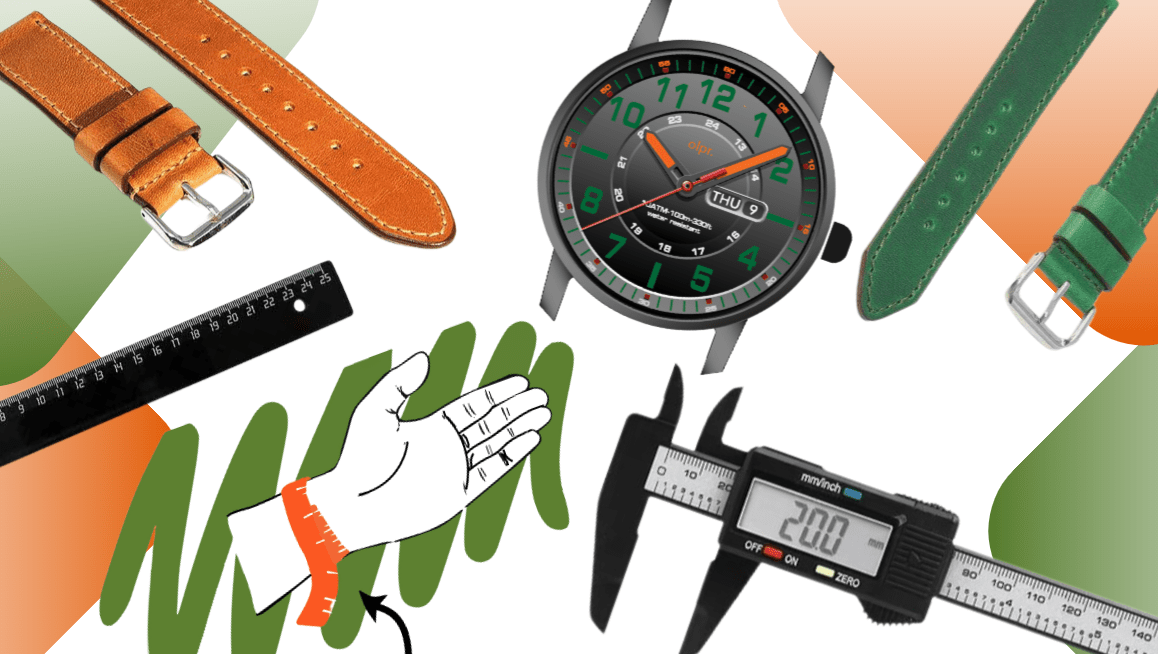
Selecting the watch strap goes beyond mere aesthetics; it involves ensuring comfort and achieving a snug fit that enhances the watch's and your wrist's appearance and feel.
Suppose you've ever dealt with a band that's either overly tight or constantly shifting around on your wrist annoyingly. You understand the exasperation it can bring about. Let's investigate all the details to ensure your watch band fits perfectly.
The Rundown
1. Measuring Your Watch Band Width
2. Measuring the Length of Metal Watch Bands
3. Watch Band Length Guide for Leather, Nylon, and Rubber Straps
4. Pro Tips for Accurate Measurements
5. Different Strap Attachment Styles
6. Conversion Chart: Inches to Millimeters
7. BONUS: Detailed Tips Table for Strap Measurement
8. Final Recommendations
The Significance of Paying Attention to the Size of Your Watch Band
Regarding ensuring your watch band fits perfectly, there are two measurements to consider: its width and length are critical factors in how comfortable and stylish your watch appears on your wrist! Even the slightest discrepancy in these dimensions can disrupt the look of your watch and cause discomfort when worn.
Measuring Your Watch Band Width
Using the Lug Width Method
The size of your watch strap is decided by how far apart the metal lugs are placed, which are tiny projections at the edges of the watch case where the band connects. Here are a couple of methods to gauge this measurement:
1. Using Digital Calipers
- This method gives you the most precise measurement.
- Place the calipers between the lugs and expand until they fit snugly.
- Record the size in millimeters.
- Pro tip: If you're between sizes, it's usually safer to round up
2. Using a Ruler
- A primary ruler works well if you don't have calipers.
- Measure the space between the lugs.
- Convert inches to millimeters (1 inch = 25.4 mm) if needed.
⚠️ Measurement Caution: Avoid phone camera measuring apps—a 1mm difference can prevent proper fitting!
3. Quick Size Check
- Look for the size stamped on your current strap. Many smartwatch bands have their width printed on the back.
- Standard sizes are 18mm, 20mm, and 22mm.
⚠️ Tip to Avoid Errors: Skip phone camera measuring apps. Even a 1mm error can result in a strap that doesn't fit!
Measuring the Length of Metal Watch Bands
Metal watch bands require extra precision because they can't stretch or adjust easily like leather or rubber straps. Here are two reliable ways to measure:
Flat Removal Method
- Remove the entire bracelet from the watch.
- Lay it flat and measure the total length.
- This gives you the most accurate measurement for a metal band.
Wrist Circumference Method
- Wrap a tape measure around your wrist to get your wrist size.
- Subtract the diameter of your watch case from this number to estimate the correct band length.
| Size | Hole Part | Buckle Part | Wrist Circumference |
|---|---|---|---|
| S | 105 mm | 65 mm | 145-165 mm |
| M | 115 mm | 75 mm | 165-185 mm |
| L | 125 mm | 85 mm | 185-205 mm |
Watch Band Length Guide for Leather, Nylon, and Rubber Straps
When it comes to non-metal straps, the process is more straightforward. Use this formula:
💡 Wrist Size - Watch Head Size = Strap Length
Quick Reference for Standard Strap Lengths
Men's Straps
| Length Category | Length Range (inches) | Length Range (mm) |
|---|---|---|
| Short | 6.50" - 6.90" | 165mm - 175mm |
| Regular | 7.00" - 7.90" | 178mm - 201mm |
| Long | 8.00" - 8.70" | 203mm - 221mm |
| Extra-Long | 8.75" - 9.25" | 223mm - 235mm |
Women's Straps
| Length Category | Length Range (inches) | Length Range (mm) |
|---|---|---|
| Short | 6.20" - 6.50" | 157mm - 165mm |
| Regular | 6.60" - 7.10" | 168mm - 180mm |
| Long | 7.20" - 8.00" | 183mm - 203mm |
Pro Tips for Accurate Measurements
First method (if you don't have a strap)
- Use a tape measure or a piece of string to measure your wrist.
- Add 1-2 cm for the comfort of the future strap (not necessary).
- Measure your watch head (usually between 1" and 1.5").
- Leather and rubber bands often have a bit of flexibility.
Here is a simplified table to help determine the appropriate watch strap length based on wrist circumference and buckle type:
Watch Strap Length Guide
| Wrist Circumference | Tang Buckle | Single Fold Clasp |
|---|---|---|
| 14.5 cm (5.7 in) | 100 mm / 60 mm | 110 mm / 50 mm |
| 15 cm (5.9 in) | 105 mm / 65 mm | 115 mm / 55 mm |
| 15.5 cm (6.1 in) | 110 mm / 70 mm | 120 mm / 60 mm |
| 16 cm (6.3 in) | 115 mm / 75 mm | 125 mm / 65 mm |
| 16.5 cm (6.5 in) | 120 mm / 80 mm | 130 mm / 70 mm |
| 17 cm (6.7 in) | 125 mm / 85 mm | 135 mm / 75 mm |
| 17.5 cm (6.9 in) | 130 mm / 90 mm | 140 mm / 80 mm |
Second method (if you already have a strap)
Start by measuring the two sections of your current watch strap. The longer section, which includes the holes, and the shorter section, which holds the buckle, are critical to determining the right fit. Precision here ensures comfort and proper alignment on your wrist.
Account for the Buckle Style
Strap lengths can vary based on the buckle type. A classic tang buckle might need more length compared to a sleek single-fold clasp. Always factor in the buckle's contribution to the overall fit when measuring.
Consult Sizing Charts
Most watch strap manufacturers offer handy sizing charts, breaking down strap lengths into categories like Small, Medium, and Large. Match your wrist size to the chart for a tailored fit.
Pro Tip: Always cross-reference your measurements with the manufacturer’s guidelines—strap designs can vary significantly.
Different Strap Attachment Styles
The way your watch strap attaches matters, too. Here are the main styles:
| Style | Description |
|---|---|
| Straight End | Compatible with most watches. |
| Curved End | Offers a snug fit and flexibility. |
| Integrated | Requires straps made specifically for your watch model. |
Conversion Chart: Inches to Millimeters
If you're measuring in inches, use this quick guide:
| Inches | Millimeters |
|---|---|
| 5/8" | 16 mm |
| 3/4" | 19 mm |
| 7/8" | 22 mm |
| 1" | 26 mm |
| Category | Measurement Method | Details & Tips |
|---|---|---|
| Watch Band Width | Using Digital Calipers | Place calipers between lugs, expand until snug. Record in mm. Round up if between sizes. |
| Using a Ruler | Measure space between lugs. Convert inches to mm (1 inch = 25.4 mm). | |
| Quick Size Check | Check the back of the strap for size (e.g., 18mm, 20mm, 22mm). Avoid phone measuring apps. | |
| Watch Band Length (Metal) | Flat Removal Method | Remove band, lay flat, and measure total length for accuracy. |
| Wrist Circumference Method | Measure wrist size, subtract watch case diameter. Refer to band size chart. | |
| Metal Band Size Chart | Size Chart:
| |
| Non-Metal Strap Length | Formula: Wrist Size - Watch Head Size | Leather and rubber straps have slight flexibility. |
| Standard Strap Lengths | Men's Straps | Short: 6.25"–6.90", Regular: 7.00"–7.90", Long: 8.00"–8.70", Extra-Long: 8.75"–9.25" |
| Women's Straps | Short: 5.75"–6.40", Regular: 6.50"–7.20", Long: 7.25"–8.00" | |
| Different Strap Attachment Styles | Straight End, Curved End, Integrated | Straight: Universal. Curved: Snug fit. Integrated: Specific to models. |
| Pro Tips for Measurement | Tape/String, Measure Twice | Measure wrist and watch head. Confirm accuracy before ordering. |
| Inches-to-Millimeters Conversion | 5/8" = 16mm, 3/4" = 19mm, 7/8" = 22mm, 1" = 26mm | Helpful for converting ruler measurements. |
Final Recommendations
- Measure twice, order once.
- Consider slight flexibility in leather and rubber straps.
- When in doubt, consult the manufacturer or professional.
Finding your perfect watch band size doesn't have to be complicated. With these expert techniques, you'll confidently select a strap that looks great and feels even better.
Ready to transform your watch's look? Measure smart, and choose wisely!
